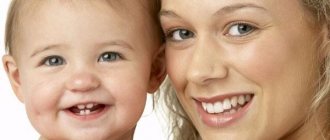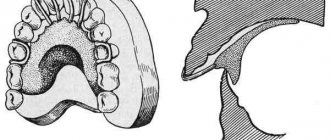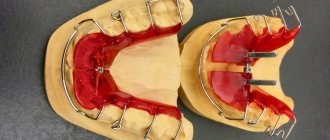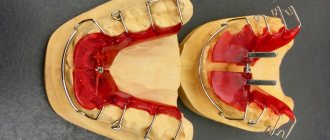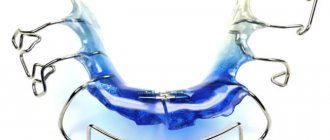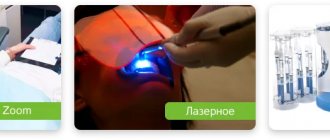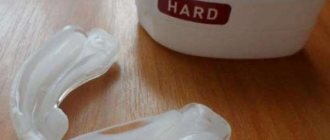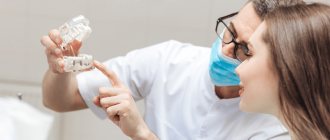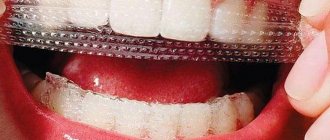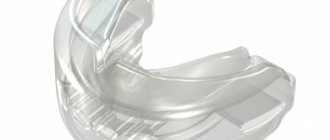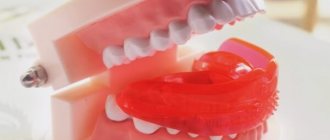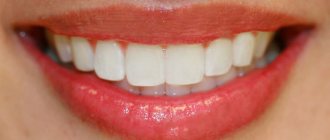A vestibular plate is a type of apparatus for correcting malocclusion. It appeared in the 70s, when Professor R. Hinz seriously began studying the causes of abnormal dental growth in children. Studies have shown that most of the patients were initially quite healthy; their bite changed under the influence of external factors.
The fact is that the child’s dental system is still mobile and labile; it can be easily corrected or damaged. The habit of sucking fingers and pacifiers often distorts teeth, leading to long-term treatment consequences. Orthodontic plates for children simultaneously correct the bite and help the child wean himself from harmful actions.
General overview
The vestibular orthodontic plate is a product made of safe plastic or silicone that the child places in his mouth. It has a fastening that makes the plate look like a regular pacifier. But, unlike pacifiers, the device does not affect the bite and does not prevent the teeth from closing.
The records are produced specifically for children and are supplied in hygienic, convenient packaging. Most kids willingly learn to wear them and exercise with them, because there is a playful aspect to the activities. In addition to its main purpose - getting rid of the pacifier - the vestibular plate can solve a number of other issues of children's health.
How to teach a child
So that the baby does not resist wearing the structure, you need to offer it to him unobtrusively. It is best to offer to play his favorite game or watch cartoons with him during this time.
If the child is older, you can try to talk to him, explaining in an accessible form the need for such a procedure. It would be wise to use the services of a psychologist, which is available at many children's orthodontic clinics.
They recruit groups of children with similar problems, where appropriate classes will be conducted with the children in a collective form. At such trainings, children willingly spend time - playing, drawing, and at the same time correction takes place.
Having developed the habit of wearing the device there, the child is unlikely to resist using it at home.
For general information about the purpose and indications for the use of orthopedic vestibular plates, see the video.
Indications for use
Whether children need a record should be decided by the doctor at the appointment. Parents need to point out the problem if there is one: the child sucks his finger, chews something, sleeps with his mouth open, etc. After an examination, the doctor recommends the product for use or not - depends on the situation.
Considering that vestibular plates are completely safe, you can safely ask for their appointment. But it is important to use them under the supervision of a specialist: you need to choose the right model, put it on correctly, etc. Errors in wearing can cause a crooked bite.
The main situations when doctors recommend purchasing a record for children :
- the child constantly chews or sucks fingers or foreign objects;
- the baby cannot refuse the pacifier, is capricious, replaces it with his finger;
- there is a habit of sleeping with the mouth open, nasal breathing is poorly developed;
- malocclusions were detected (especially the open type), etc.
What do children's dental plates look like?
A plate made in a pediatric dental laboratory is a standard of aesthetic perfection. Any shades, gradient colors, sparkles and bright decorations inside translucent plastic - children are delighted when they see it for the first time.
Structurally, the plate is:
- the base is strong and quite rigid;
- elastic wire - fasteners, arches and hooks are made from it, and it is this wire that provides the necessary pressure to correct the bite;
- the screw is an activator responsible for pressure and intensity of impact.
The screw is tightened by the doctor with a special key, or this is done by the parents according to the correction plan drawn up.
Soldatenkova Alina
I am often asked how dental plaques are made for children. First, we take impressions of the teeth – it doesn’t hurt, but sometimes it’s a little unpleasant. Then, based on the impressions, the appliance prescribed by the orthodontist is manufactured in a dental laboratory. Then try it on and create a design that is comfortable to wear. And issuing a plate to the patient with recommendations for wearing
Sizes and types. What are they made of?
Most plates are made either from food-safe plastic, which provides a rigid frame, or from soft silicone. The choice of material depends on the doctor's decision. Children's plates are made in two sizes:
- first (I) for children with primary malocclusion. Its radius is 22.5 mm. The product can be distinguished by the characteristic red color of the ring;
- the second (II) for children with mixed dentition. Its radius is 30 mm. She has a dark blue ring.
There are several varieties of vestibular plates . All of them appeared later than the standard one and, in addition to the development of nasal breathing, help to cope with the problems of a “flaccid” tongue, eliminate speech defects, correct swallowing, etc. The three most popular models are: classic, with a bead, with a flap and with a visor.
Model with visor
The visor appeared on vestibular orthodontic plates when doctors realized that it was difficult for children with underdeveloped jaws and protrusion of the upper frontal teeth to hold the classic model in their mouth. For them, it constantly deviated above the sagittal protrusion, and at night it completely fell out. The presence of a visor solves this problem.
The vestibular plate with a soft or hard visor is ideal for the treatment of all class II abnormalities. It also stops the development of class III anomalies if worn with the visor up. Due to the fact that the product pushes the upper jaw forward, wearing it normalizes the position of the jaws relative to each other.
Model with damper
The tongue deflector plate is designed for those children who are accustomed to placing their tongue between their teeth when swallowing and speaking. This habit interferes with the normal growth of teeth and leads to the formation of an “open” bite. The flap pushes the tongue back and forces it into the correct position.
In addition, a vestibular plate with a tongue flap helps:
- eliminate the habit of breathing through your mouth;
- teach the child to correctly position the tongue in the mouth during speech;
- strengthen the circular muscle of the tongue, normalize lip closure.
Because the model is often used with speech therapists to demonstrate proper tongue placement, it is made transparent.
Model with bead
The vestibular bead plate is used primarily to correct speech problems. It helps stimulate “flaccid tongue” in children with speech impediments. The standard plate itself aligns the position of the tongue, teeth, lips, helping to improve diction, and an additional design element enhances the effect.
There are two models of bead plate :
- classical. It has an extended bead that stimulates the root of the tongue. This model helps with dysarthria, increased muscle tone, impaired pronunciation of hard and soft consonants, rhinolalia, tachylalia, as well as in the treatment of stuttering. It helps to train weakened tongue muscles;
- new model. Her bead is moved closer to the plastic base and teeth. This model of plate is recommended for children with reduced tone of the tip of the tongue, various forms of sigmatism, lambdacism, and problems with the pronunciation of the “r” sound.
If for some reason a parent wants to buy a record without a doctor’s recommendation, it is advisable to purchase a standard model. It is universal, easy to use, and there is no negative effect when using it. All specialized models - with a bead, a visor, a flap - must be purchased exclusively on the recommendation of a doctor.
Causes of malocclusion
Malocclusion can be caused by a hereditary factor or certain diseases, such as rickets. But more often than not, this is the result of “bad” childhood habits, such as:
- prolonged pacifier sucking (up to 3 years or more);
- feeding from bottles with non-anatomically shaped nipples;
- finger sucking.
For older children, the habit of constantly biting nails or pencils can also have an impact on the position of the primary teeth and the development of incorrect articulation. It was for them that the original vestibular plate with a bead from Dr. was developed. Hinz.
Advantages and disadvantages
Vestibular plates are prescribed to children quite often because they are very effective and have almost no contraindications. The advantages of records are:
- ease of use and maintenance;
- need to be worn overnight and for several hours during the day (does not require use all the time like braces);
- low cost;
- training in a playful way;
- possibility of use from an early age;
- presence of other effects (strengthening speech organs, etc.)
The disadvantages include, first of all, a narrow range of influences. Plates cannot cope with all problems. Also, due to the ability to remove the product, the treatment time is extended.
Kraus vestibulo-oral plate
The product includes two elements:
- vestibular;
- oral.
Both fragments are fastened with pieces of wire, which is located in the spaces of the incisors, canines and molars of the upper dentition.
The system is indicated for those with the habit of thumb sucking, inserting the tongue between bone organs during conversation, and with the infantile form of swallowing.
The advantage of the model is that the design corrects speech pathologies that other vestibular plates may not be able to do due to their neglect.
Use for malocclusion in children
Often, plates are prescribed to young children when their malocclusion has already formed. There are indications for this: the product is not effective in all cases. Since plates are primarily preventive devices, they cannot cope with very severe disorders.
Plates can affect teeth that have either protruded forward, are not very straight, or can be corrected by influencing other elements in the dentition. If a child experiences incorrect eruption (the tooth has grown in the palate, is turned incorrectly, etc.), this cannot be corrected with plates. That is why these orthodontic products are used primarily for early treatment of malocclusion. At 6-7 years old, the orthodontist recommends trainers that have a wider range of capabilities.
Read more about trainers and treatment with their help in our article: “Trainers for straightening teeth: description, varieties, tips for use.”
Trainers Myobrace
Myobrace trainers are manufactured by Myofunctional Research Co. Customized Myobrace trainers, available in different sizes, have found their use as devices for myofunctional training, as well as retention equipment for fixing the bite after removing braces. Often used as devices before wearing braces to widen the jaws and straighten teeth. Used in children 8-15 years old.
The timing and pattern of wearing myofunctional trainers for teeth and vestibular plates is determined by the doctor.
In addition to Myobrace trainers, our specialists can offer EF Line Orthoplus myofunctional devices.
In order to start treatment on time, you just need to show your child to the pediatric dentist once every six months after the first teeth erupt. If the doctor notices a problem, he will recommend a consultation with a pediatric orthodontist. Often, a child needs accompanying supervision from specialists such as an ENT doctor, speech therapist, osteopath, or child psychologist.
Make an appointment for a consultation by phone +7-499-110-18-01 or through the form on the website. You can ask questions about correcting your bite to the chief doctor of the clinic, Sergei Vladimirovich Tsukor, at
Treatment with devices
The vestibular plate is primarily a therapeutic orthodontic device. It must be worn in accordance with the recommendations of doctors. Treatment can begin at 3 years of age, when the baby’s primary dentition is partially formed. Also, the plate can be worn throughout the entire mixed dentition. On a permanent bite, the device no longer has any effect.
Do not forget that there is a vestibular plate for the primary and secondary occlusions.
Types of orthodontic plates
Depending on the type of construction, individual vestibular plates can be removable or non-removable. We will not consider fixed structures, since they are used extremely rarely in orthodontic practice.
7 types of removable orthodontic vestibular plates:
1. Frenkel system – a removable plate with protective elements for lips and cheeks;
2. For one jaw – a vestibular plate, which is used to correct the position of single teeth;
3. Bruckle system - a plate designed to correct a strongly protruded chin;
4. A plate equipped with a retraction arc - a device that is necessary to correct the position of the incisor teeth;
5. The Andresen-Goipl system, affecting the lower and upper jaws;
6. A removable plate with a push element is designed to expand the patient's upper jaw;
7. A plate with a process, necessary for the correction of one tooth (most often incisors).
Conclusions. Expert advice
The vestibular plate is a simple and effective method for correcting malocclusion and speech problems at an early age. It helps get rid of the following problems:
- mouth breathing and poor development of nasal breathing;
- low tone of the orbicularis oris and lingual muscles;
- speech defects, infantile type of swallowing, incorrect development of the jaws.
Wearing the product helps stimulate natural self-regulation processes, so the capabilities of the plates are limited. But choosing one of the modifications will help expand them. The following types of records exist:
- standard,
- with damper,
- with a bead,
- with a visor.
Each has additional capabilities and specifics. For example, a model with a bead is recommended mainly by speech therapists, and a plate with a visor is recommended to be worn for abnormalities in the development of the jaws.
You should not buy vestibular plates for children without a doctor’s recommendation. It is better to visit an orthodontist so that he can confirm the need for the product and that it will not cause harm. Also, be sure to keep the product clean: wash it regularly and treat it with an antibacterial agent.
Frenkel function apparatus
It consists of two buccal shields and two lip pads made of plastic, interconnected by a metal frame - a palatal clasp, lingual and vestibular arches and other parts.
It is used in primary, mixed and permanent dentition for the treatment of anomalies in the position of the anterior teeth, distal deep bite with protrusion of the anterior teeth /type 1/, for the treatment of distal deep bite combined with retrusion of the upper anterior teeth /type 2/, for the treatment of mesial occlusion / type Z/, for the treatment of open bite /type 4/.
The object of the device's influence is the muscles, the training of which helps to normalize functions. Closing of the lips is achieved - normalization of breathing function and tongue position. The pressure around and intraoral muscles is transmitted to the dentition and alveolar process of the jaws, helping to correct the bite in the sagittal, vertical and transverse directions.
Author of the article: Elena Yurievna Krivopusk, orthodontist
Dear Colleagues! When copying information, placing a link to the source site is mandatory!
